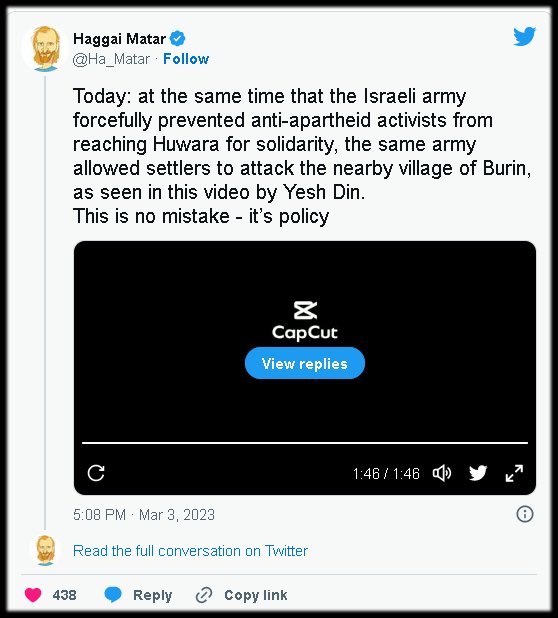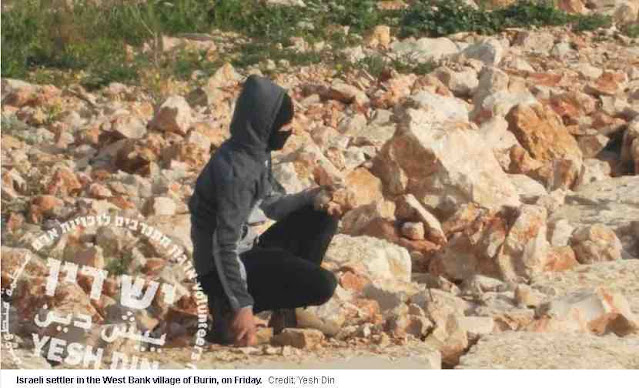But later they fire tear gas at Palestinians trying to defend themselves – this is worse than Apartheid in South Africa
This film is taken by human rights group Yesh Din and was printed today in Ha’aretz in an article below. It demonstrates beyond doubt that the Israeli military have one purpose and one purpose alone in the West Bank – to defend the settlers and to further the colonisation of the land.
That is why armed resistance by the Palestinians is perfectly justifiable and why the settlers are also legitimate military targets. The Quisling Palestinian Authority should be dismantled. It serves no purpose other than to act as the enforcer of the Israeli Occupation Authorities.
Tony Greenstein

In a video documenting the incident, the rioters are seen vandalizing trees and throwing stones, as soldiers stand by without trying to stop or detain them. According to Israeli NGO Yesh Din which published the video, three Palestinian houses were damaged
Hagar Shezaf Mar 4, 2023 8:11 am IST
Israeli settlers were documented throwing stones at Palestinian houses in the West Bank village of Burin on Friday, as IDF soldiers were present and stood by.
In a video published by Israeli human rights organization Yesh Din, the rioters, some of them masked, are seen throwing stones and destroying trees belonging to Palestinians – while Israeli soldiers stand by without trying to stop or detain them.
According to Yesh Din, three houses in the village were damaged by the stones. Soldiers were later seen firing tear gas into the area, and several local residents were injured by inhaling the gas, according to the organization.
The army says it is investigating why the soldiers did not act immediately, adding that after a military force that arrived in the village responded with crowd-control measures, order was restored.

The village of Burin is located near the settlement of Yitzhar and the Giv’at Ronen outpost, as well as the Palestinian town of Hawara. According to evidence, during the settlers’ rampage in Hawara earlier this week, riots also took place in Burin, resulting in damages to several houses in the village.
Security establishment officials estimated that approximately 400 settlers took part in the riots in Hawara, which broke out after the murder of brothers Hillel and Yigal Yaniv by a Palestinian assailant. During the riots, a Palestinian man was shot dead and dozens were injured. The attackers caused extensive damage to property, set cars and buildings on fire and slaughtered sheep.
Central Command chief Maj. Gen. Yehuda Fuchs called the incident “a pogrom carried out by lawbreakers” and admitted that the army was not properly prepared to prevent it. “This is a disgraceful event by lawbreakers who acted not in accordance with the values on which I was raised, not in accordance with the values of the State of Israel and also not in accordance with the values of Judaism,” Fuchs said.
On Friday morning, the army prevented hundreds of left-wing activists who came to Hawara to express support for residents from entering the town, and threw stun grenades at them. The IDF declared the area a “closed military zone” and prevented the buses with which the Israelis arrived from moving forward. The activists then walked towards the town while demonstrating, and at least four were detained when they tried to cross the army blockade. One of the activists said he was beaten by soldiers. A soldier was also seen confronting former Knesset speaker and Jewish Agency chairman Avrum Burg, knocking him to the ground.
‘I couldn’t see if my brother’s murderer was a soldier or settler’
Footage obtained by +972 shows Sameh Aqtesh was shot dead during a settler attack accompanied by the Israeli army on the night of the Huwara pogrom.
By Oren Ziv and Yuval Abraham March 5, 2023
Last Sunday night, when Israeli settlers launched a pogrom on the West Bank town of Huwara, a Palestinian man, Sameh Aqtesh, was fatally shot during a simultaneous settler attack in the nearby village Za’atara. And according to an analysis of 14 videos by Palestinian residents obtained by +972 and Local Call, Israeli soldiers — as in Huwara — were escorting the settlers during the shooting of Aqtesh.
According to the testimonies and videos, the incident began on Feb. 26 at around 7 p.m., when masked settlers came down to Za’atara from Tapuach Junction, a major traffic artery nearby, and began attacking homes in the village. Palestinian residents reacted by throwing stones at the attackers, forcing the settlers to retreat.
An hour and a half later, the settlers returned to the village — this time with soldiers backing them up. In a video recorded moments after Aqtesh’s shooting, taken on Sunday at 8:44 p.m., at least three soldiers, two military jeeps, and what appears to be a police vehicle are seen accompanying a group of around 40 settlers.
Footage of Samer Aqtesh’s killing:
“The settlers came twice,” said Abed Aqtesh, Sameh’s older brother.
“The first time, they came alone and we managed to drive them away. The second time they came back with soldiers and with the settlement security coordinator. There were about 50 settlers; they threw stones at us, and had jerry cans full of gasoline. We threw stones at them.”
In the video recording of the moment of the shooting, one of the Palestinian residents is heard saying, “Don’t be afraid,” while some of the settlers shine flashlights and laser pointers in what appears to be an attempt to blind the residents. Then two more shots are heard, and one of the residents is heard saying: “It’s in the air.” Five more shots are fired. The Palestinian residents are heard saying: “They are shooting at us — ambulance.” This was likely the moment Aqtesh was hit.
At the end of the video, two more shots are heard as well as another call for help. Throughout the video, no Palestinian residents are seen throwing stones or confronting the settlers or the soldiers. After the shooting, the video shows a settler throwing stones again.
“They started shooting live fire. They didn’t throw gas, stun grenades, or rubber bullets, — it was immediate live fire,” Abed continued. “Everything was dark. I didn’t see if the person who murdered my brother was a soldier or a settler.”